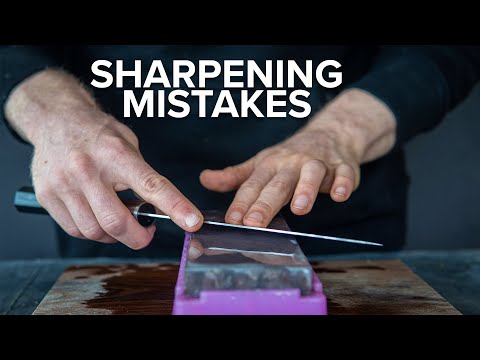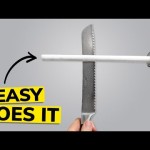
b57c575a3c2fe9a7dfb15a8a3ae05193
Sharpening a knife is an important part of kitchen maintenance. A sharp knife is safer to use and will make your cooking tasks easier. A large whetstone is an effective tool for sharpening a knife, and it is relatively easy to use. In this article, we will discuss the basics of sharpening a knife with a large whetstone, including the materials you will need, the steps involved, and tips for getting the best results.
Does whetstone size matter
When it comes to sharpening knives, whetstones are a popular choice. But does the size of the whetstone matter?
The size of the whetstone is important for a few reasons. First, the size of the stone will determine how much of the blade can be sharpened at once. A larger stone will allow you to sharpen more of the blade in one go, while a smaller stone will require more passes to sharpen the entire blade.
The size of the stone will also affect the type of sharpening you can do. A larger stone will be better for honing and polishing the blade, while a smaller stone will be better for more precise sharpening.
The size of the stone will also affect the amount of time it takes to sharpen the blade. A larger stone will require less time to sharpen the blade, while a smaller stone will take longer.
Finally, the size of the stone will affect the cost. A larger stone will be more expensive than a smaller stone, but it will also last longer and be more versatile.
In conclusion, the size of the whetstone does matter. Depending on your needs, you may want to choose a larger or smaller stone. A larger stone will be better for honing and polishing, while a smaller stone will be better for more precise sharpening. A larger stone will also require less time to sharpen the blade, but it will be more expensive.
Can you ruin a knife with a whetstone
Sharpening a knife with a whetstone is a great way to keep your knife in top condition. But can you ruin a knife with a whetstone? The answer is yes, but it is unlikely if you use the right technique.
Using a whetstone to sharpen a knife requires skill and patience. If you don’t use the correct technique, you can damage the blade. You should always use a light touch when sharpening a knife with a whetstone. If you press too hard, you can cause the blade to become too thin and weak. This can lead to the blade chipping or breaking.
It is also important to use the right type of whetstone for your knife. Different types of knives require different types of whetstones. If you use the wrong type of whetstone, you can damage the blade. For example, a coarse whetstone is not suitable for a delicate blade.
It is also important to use the right amount of pressure when sharpening a knife with a whetstone. Too much pressure can cause the blade to become too thin and weak. Too little pressure can cause the blade to become dull and not sharp enough.
Finally, it is important to use the right amount of lubricant when sharpening a knife with a whetstone. Too much lubricant can cause the blade to become too slippery and difficult to control. Too little lubricant can cause the blade to become too dry and cause it to become dull.
In conclusion, it is possible to ruin a knife with a whetstone if you don’t use the right technique. However, if you use the correct technique and the right type of whetstone, you should be able to keep your knife in top condition.
How do you sharpen a knife with a king whetstone
Sharpening a knife with a king whetstone is a simple process that can help you keep your knives in top condition.
A king whetstone is a type of sharpening stone that is made from a combination of aluminum oxide and silicon carbide. It is designed to be used with water, and it is an ideal choice for sharpening knives. Here is a step-by-step guide to help you sharpen your knives with a king whetstone.
Step 1: Gather Your Supplies
Before you begin sharpening your knives, you will need to gather the necessary supplies. You will need a king whetstone, a container of water, a towel, and a knife sharpening tool. You may also want to have a pair of gloves to protect your hands from the sharpening process.
Step 2: Soak the Whetstone
Once you have gathered your supplies, you will need to soak the king whetstone in water for at least 10 minutes. This will help to ensure that the stone is properly lubricated and ready for use.
Step 3: Place the Knife on the Whetstone
Once the whetstone is soaked, you can begin sharpening your knife. Place the knife on the whetstone at a 20-degree angle and begin to move it back and forth in a sawing motion. Make sure to keep the blade in contact with the stone at all times.
Step 4: Flip the Knife and Repeat
Once you have sharpened one side of the blade, you will need to flip the knife over and repeat the process on the other side. Make sure to keep the blade in contact with the stone at all times and to use a consistent sawing motion.
Step 5: Rinse and Dry the Knife
Once you have finished sharpening the knife, you will need to rinse it off with water and dry it with a towel. This will help to remove any debris that may have been created during the sharpening process.
Step 6: Test the Knife
Once you have finished sharpening the knife, you will need to test it to make sure that it is sharp enough. You can do this by slicing a piece of paper or a tomato. If the knife is sharp enough, it should easily slice through the paper or tomato.
Conclusion
Sharpening a knife with a king whetstone is a simple process that can help you keep your knives in top condition. By following the steps outlined above, you can easily sharpen your knives with a king whetstone and keep them in top condition.
How many passes does it take to sharpen a knife on a whetstone
Sharpening a knife on a whetstone is a great way to keep your knives in top condition. But how many passes does it take to get the job done? The answer depends on the type of knife, the condition of the blade, and the skill of the sharpener.
For a standard kitchen knife, it usually takes between 10 and 20 passes on the whetstone to get a sharp edge. The number of passes can vary depending on the type of steel used in the blade, the angle of the blade, and the sharpener’s technique. If the blade is in good condition, it may take fewer passes to sharpen it. If the blade is dull or damaged, it may take more passes.
To sharpen a knife on a whetstone, start by wetting the stone with water or oil. Place the blade on the stone at a 20-degree angle and make a few passes on each side of the blade. Make sure to keep the angle consistent and use even pressure. After a few passes, check the blade for sharpness. If it’s not sharp enough, continue making passes until it is.
Sharpening a knife on a whetstone is a skill that takes practice. It’s important to take your time and be patient. With practice, you’ll be able to sharpen your knives quickly and efficiently. And you’ll be able to keep your knives in top condition for years to come.
Thank you for reading this article about sharpening your knife with a large whetstone. We hope that you now have a better understanding of the process and the tools you need to get the job done. Goodbye and good luck!















